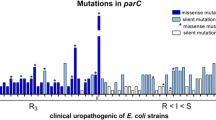Abstract
In a ten-year survey (1983–1992) of quinolone resistance inEscherichia coli causing urinary tract infections in a general practice patient population, 9,934 strains were tested. Resistance increased remarkably from 1989 onwards. The rate of resistance to pipemidic acid was ≤6 % before 1989 and 18 % in 1992; the rate of resistance to ciprofloxacin (MIC≥4mg/l) was 0.8 % in 1989 and 7.1 % in 1992. Although the consumption of older quinolones decreased the total consumption of quinolones increased yearly.
Similar content being viewed by others
References
Waldvogel FA Clinical role of the quinolones today and in the future. European Journal of Clinical Microbiology & and Infectious Diseases 1989, 8: 1075–1079.
National Committee for Clinical Laboratory Standards Performance standards for antimicrobial disk susceptibility tests. Approved standard M2-A4. NCCLS, Villanova, PA, 1990.
National Committee for Clinical Laboratory Standards Methods for dilution antimicrobial susceptibility tests for bacteria that grow aerobically. Approved standard M7-A2. NCCLS, Villanova, PA, 1990.
Moellering RG Interaction between antimicrobial consumption and selection of resistant bacterial strains. Scandinavian Journal of Infectious Diseases 1990, Supplement 70: 18–24.
Kling PA, Östensson R, Granström S, Burman LG A 7-year survey of drug resistance in aerobic and anaerobic fecal bacteria of surgical inpatients: clinical relevance and relation to local antibiotic consumption. Scandinavian Journal of Infectious Diseases 1989, 21: 589–596.
Westh H, Jensen BL, Rosdahl VT, Prag J Development of erythromycin-resistance inStaphylococcus aureus as a consequence of high erythromycin consumption. Journal of Hospital Infection 1989, 14: 107–115.
Blumberg HM, Rimland D, Carroll DJ, Terry P, Wachsmuth IK Rapid development of ciprofloxacin resistance in methicillin-susceptible and -resistantStaphylococcus aureus. Journal of Infectious Diseases 1991, 163: 1279–1285.
Muder RR, Brennen C, Goetz AM, Wagener MM, Rihs JD Association with prior fluoroquinolone therapy of widespread ciprofloxacin resistance among gram-negative isolates in a Veterans Affairs Medical Center. Antimicrobial Agents and Chemotherapy 1991, 35: 256–258.
Cohen SP, McMurry LM, Hooper DC, Wolfson JS, Levy SB Cross-resistance to fluoroquinolones in multiple antibiotic resistantEscherichia coli selected by tetracycline or chloramphenicol: decreased drug accumulation associated with membrane changes in addition to OmpF reduction. Antimicrobial Agents and Chemotherapy 1989, 33: 1318–1325.
Author information
Authors and Affiliations
Rights and permissions
About this article
Cite this article
Pérez-Trallero, E., Urbieta, M., Jimenez, D. et al. Ten-year survey of quinolone resistance inEscherichia coli causing urinary tract infections. Eur. J. Clin. Microbiol. Infect. Dis. 12, 349–351 (1993). https://doi.org/10.1007/BF01964432
Issue Date:
DOI: https://doi.org/10.1007/BF01964432




